The rich history of Filipino theatre reflects a fascinating blend of tradition and innovation. Rooted in ancient performance practices, it has evolved significantly under American cultural influence. This transformation highlights the adaptability of Filipino art forms and their ability to absorb new ideas while preserving their essence.
From traditional komedya and zarzuela to modern adaptations, Filipino theatre has always been a mirror of society. The introduction of Broadway-style productions and Shakespearean plays in the 1930s marked a turning point. These changes were driven by Westernized education and the growing influence of American culture.
Physical places like Teatro Zorilla and the Manila Grand Opera House became iconic venues for these performances. They provided a stage for artists to experiment and audiences to experience the evolving art form. This blend of old and new continues to shape Filipino theatre today.
Key Takeaways
- Filipino theatre evolved under American cultural influence.
- Traditional forms like komedya and zarzuela laid the foundation.
- Broadway and Shakespearean plays were introduced in the 1930s.
- Iconic venues like Teatro Zorilla played a key role.
- The blend of old and new continues to shape modern theatre.
Historical Roots of Filipino Theater
Long before formal stages, Filipinos expressed stories through ritualistic performances. These early forms of drama were deeply tied to ancestral rituals and community gatherings. They served as a way to honor spirits, celebrate harvests, and pass down traditions.
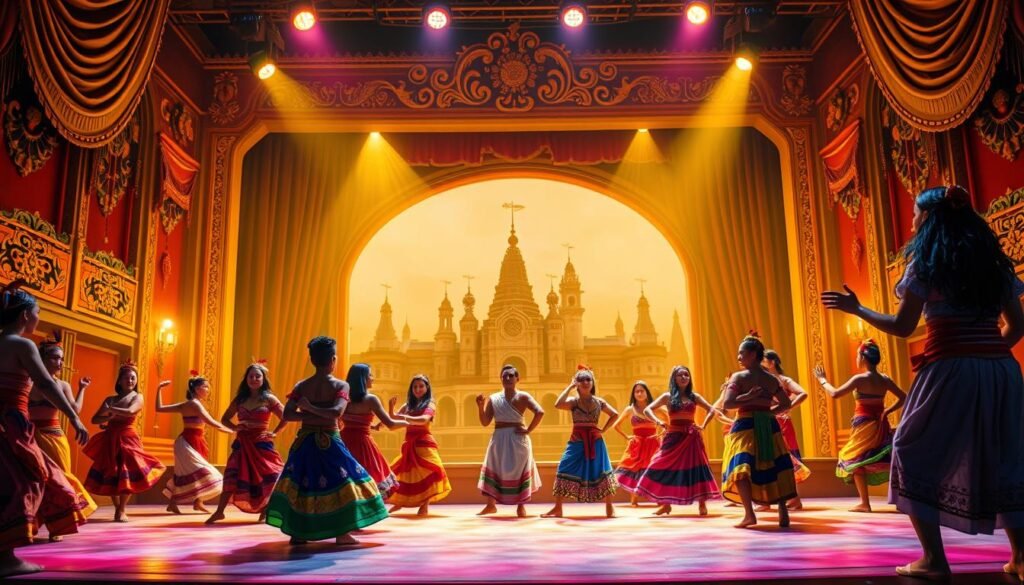
In pre-colonial times, performances were often held in open spaces, engaging entire audiences. These events combined music, dance, and storytelling to create a powerful spectacle. They were not just entertainment but also a means of teaching moral lessons and preserving cultural identity.
Pre-colonial and Indigenous Foundations
Indigenous performances were rooted in spirituality and daily life. Rituals like the pamamanhikan (courtship ceremony) and pagdiwata (healing ritual) included dramatic elements. These practices laid the groundwork for later forms of performance in the country.
Spanish Legacy and Early Rituals
Spanish colonization introduced European dramatic forms, transforming local traditions. The comedia, a religious play, became a tool for spreading Christianity. The sinakulo, depicting the passion of Christ, remains a Lenten tradition. These adaptations blended foreign influences with Filipino storytelling.
| Period | Key Performances | Purpose |
|---|---|---|
| Pre-colonial | Rituals, storytelling | Spiritual, educational |
| Spanish Era | Comedia, Sinakulo | Religious, instructional |
These historical roots continue to shape Filipino drama today. Modern performances often draw inspiration from these early traditions, blending them with contemporary themes.
American Influence on Traditional Filipino Theater
The early 20th century marked a pivotal shift in Filipino performance art. With the arrival of American colonial rule in 1901, new ideas and techniques began to shape local traditions. This period of time saw the introduction of English-language plays and modern staging methods.
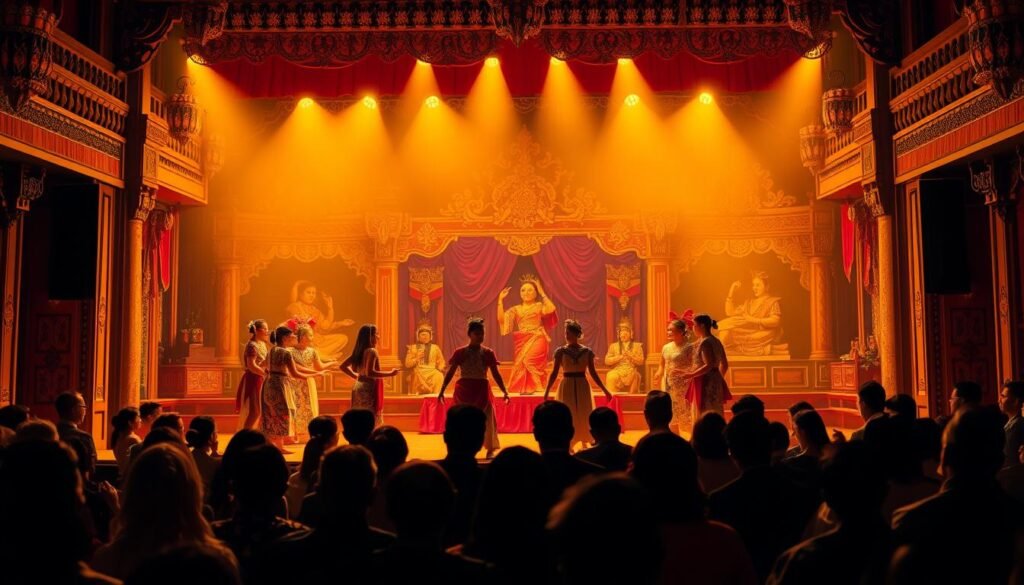
Cultural Exchanges and Adaptations
American influence brought a fresh word to Filipino drama. Plays like “A Modern Filipina” (1915) showcased the blending of Western and local storytelling. Over time, Filipino artists adapted these new forms while preserving their cultural roots.
Key persons in the entertainment industry played a crucial role. Figures like Wilfrido Ma. Guerrero wrote plays that reflected the concerns of the educated middle class. Their work bridged the gap between traditional and modern styles.
Shifts in Performance Style and Production
Performance spaces also evolved during this time. Traditional buildings were reimagined to suit modern productions. The introduction of proscenium stages and the fourth wall transformed how audiences experienced drama.
Cultural exchange was not one-sided. Filipino artists incorporated American techniques while adding their unique flair. This blend created a dynamic and evolving art form that continues to thrive today.
| Period | Key Changes | Impact |
|---|---|---|
| 1901-1946 | Introduction of English-language plays | Expanded storytelling possibilities |
| 1930s-1950s | Modern staging techniques | Enhanced audience engagement |
| 1950s-1980s | Blend of traditional and modern styles | Preserved cultural identity |
Evolution of Theater Design and Architecture
From ancient open-air structures to modern stages, the architecture of performance spaces reflects cultural shifts. These designs have evolved to meet the needs of actors and audiences, blending tradition with innovation.
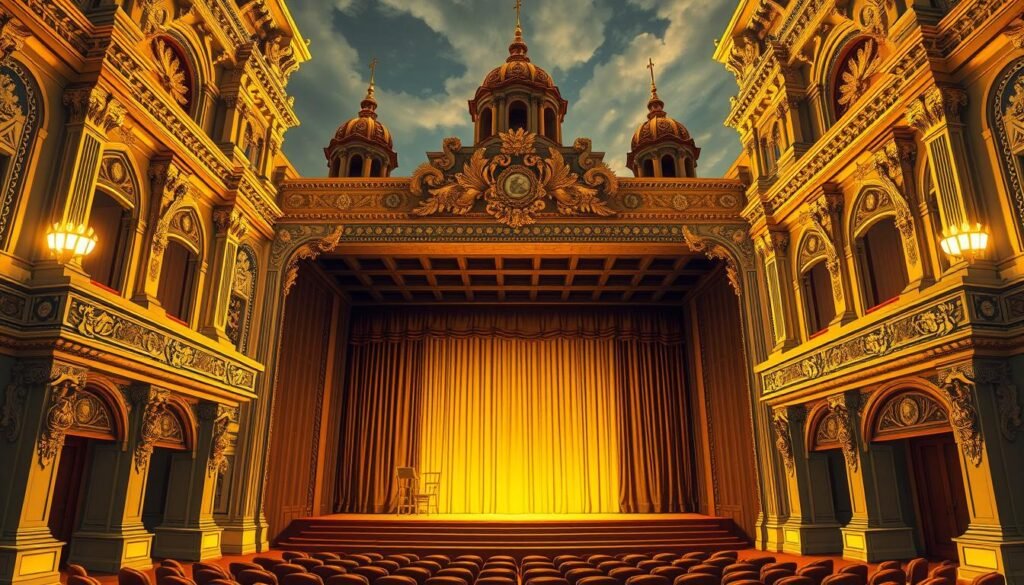
Inspirations from Ancient Greek and Roman Models
Ancient Greek and Roman models laid the foundation for performance spaces. The Theatre of Dionysus, built around 330 BCE, could hold over 17,000 people. These open-air structures were designed to enhance acoustics and visibility.
Roman theatres, like the Theatre of Pompey, introduced more elaborate designs. They featured raised stages and intricate backdrops. These innovations influenced performance spaces across the world.
Unique Filipino Spatial Transformations
Filipino performance spaces adapted these ancient principles to local needs. Traditional komedya stages were often simple, open areas. Over time, these spaces evolved to include more complex designs.
Modern Filipino stages now incorporate elements like proscenium arches and movable scenery. These changes support the activity of actors and enhance storytelling. Local artists have also added cultural motifs to these designs.
Modern Stagecraft and Technological Advancements
Today’s performance spaces are equipped with advanced technology. Lighting, sound systems, and moving scenery create immersive experiences. These tools allow actors to bring stories to life in new ways.
Filipino stages now feature innovations like automated rigging and digital projections. These advancements ensure that every day of a performance is seamless. The blend of tradition and technology continues to shape the world of performance art.
| Period | Key Features | Impact |
|---|---|---|
| Ancient Greece | Open-air structures, enhanced acoustics | Foundation for modern design |
| Roman Era | Raised stages, intricate backdrops | Influenced global performance spaces |
| Modern Philippines | Proscenium arches, cultural motifs | Blended tradition with innovation |
Modern Adaptations in Filipino Performance Art
The fusion of Western and Filipino dramatic techniques has shaped a unique performance art landscape in the Philippines. Over the century, this blending has created a dynamic space where tradition meets innovation. Today, Filipino artists continue to draw from both worlds, crafting performances that resonate globally.
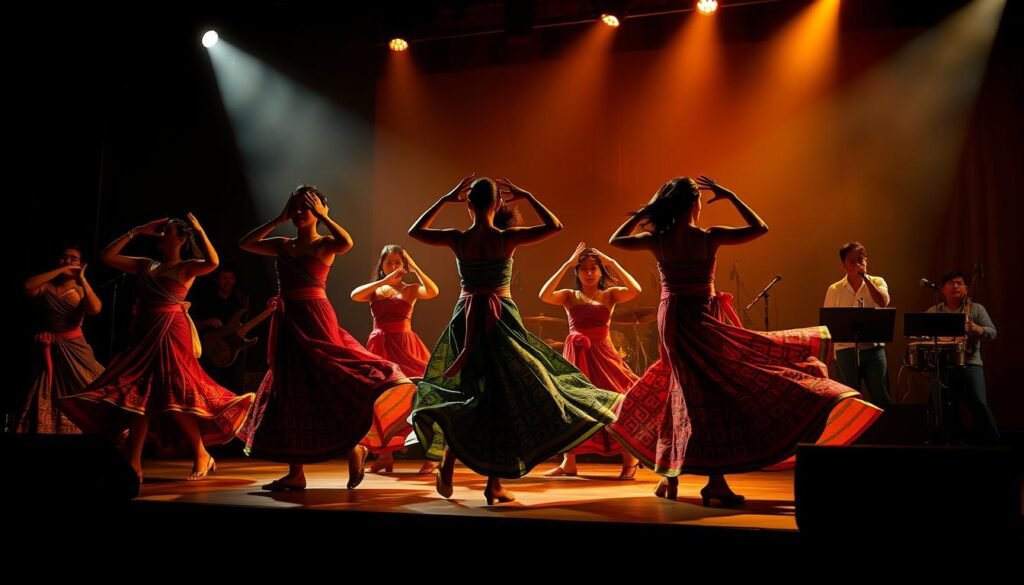
Integration of Western Dramatic Techniques
Western dramatic forms have significantly influenced Filipino performance art. Plays like “Sa Aming Puso / In Our Hearts” showcase bilingual storytelling, blending English and Tagalog. This approach reflects the ongoing cultural synthesis in the new era of Filipino drama.
Universities have played a pivotal role in this evolution. Institutions like the University of the Philippines have preserved traditional forms while encouraging experimentation. Academic programs often include both classical and modern techniques, ensuring a rich history of performance art.
Shifts in Production and Performance Practices
The century has seen dramatic changes in how performances are staged. Modern productions incorporate advanced lighting, sound systems, and digital projections. These tools enhance storytelling while maintaining cultural authenticity.
For example, the adaptation “Ma’am Lys” draws inspiration from real-life events in Mindanao. It combines traditional themes with contemporary staging, creating a powerful narrative. Such productions highlight the adaptability of Filipino artists.
“The blend of heritage and innovation is what makes Filipino performance art truly unique.”
Contemporary Productions Blending Heritage and Innovation
Recent productions like “Ang Huling El Bimbo” have gained widespread acclaim. They merge traditional music with modern storytelling, appealing to diverse audiences. These works demonstrate the enduring relevance of Filipino culture in the global stage.
Universities continue to support these efforts, offering platforms for young artists to experiment. This academic involvement ensures that the history of Filipino performance art remains alive while embracing new ideas.
| Period | Key Developments | Impact |
|---|---|---|
| Early 20th Century | Introduction of Western dramatic forms | Expanded storytelling possibilities |
| Mid-20th Century | Academic contributions from universities | Preserved traditional techniques |
| 21st Century | Use of modern technology in productions | Enhanced audience engagement |
The evolution of Filipino performance art is a testament to its resilience and creativity. By integrating Western techniques with local traditions, artists continue to push boundaries. This blend ensures that Filipino drama remains vibrant and relevant in the modern world.
Glossary of Theater Terminology
Understanding the language of performance art is essential to appreciating its depth. This glossary defines key terms used in both historical and modern contexts, offering insights into the craft of drama. Whether you’re a seasoned enthusiast or a curious newcomer, these definitions will enhance your understanding of the production process.

Key Terms and Definitions
Here are some essential terms that bridge cultures and eras in performance art:
- Act: A division of a play, often broken into scenes. Acts help structure the narrative and pacing of a performance.
- Ad-lib: Improvised lines spoken by actors, derived from the Latin term ad libitum. This technique adds spontaneity to a production.
- Amphitheater: An open-air venue with curved seating, commonly used in ancient Greek and Roman performances.
- Curtain Call: The moment at the end of a performance when actors bow to the audience, acknowledging their applause.
Usage in Historical and Modern Contexts
Many terms have evolved over time, reflecting changes in performance styles and technologies. For example, the English word “amphitheater” originates from ancient Greek architecture but is now used globally to describe similar venues.
In Filipino drama, traditional terms like komedya coexist with modern adaptations. This blend highlights the adaptability of performance art across cultures.
“The language of drama is a living testament to its evolution, connecting past and present.”
Understanding these terms not only enriches your appreciation of drama but also reveals the intricate part each element plays in a successful production. From ancient rituals to modern stages, the vocabulary of performance art continues to shape its storytelling.
Role of Plays in Shaping National Identity
Filipino plays have long served as a mirror to the nation’s evolving identity. From the Spanish colonial era to modern times, drama has been a powerful tool for expressing collective experiences and aspirations. These productions often reflect the struggles, triumphs, and values of the Filipino community, making them a vital part of cultural heritage.
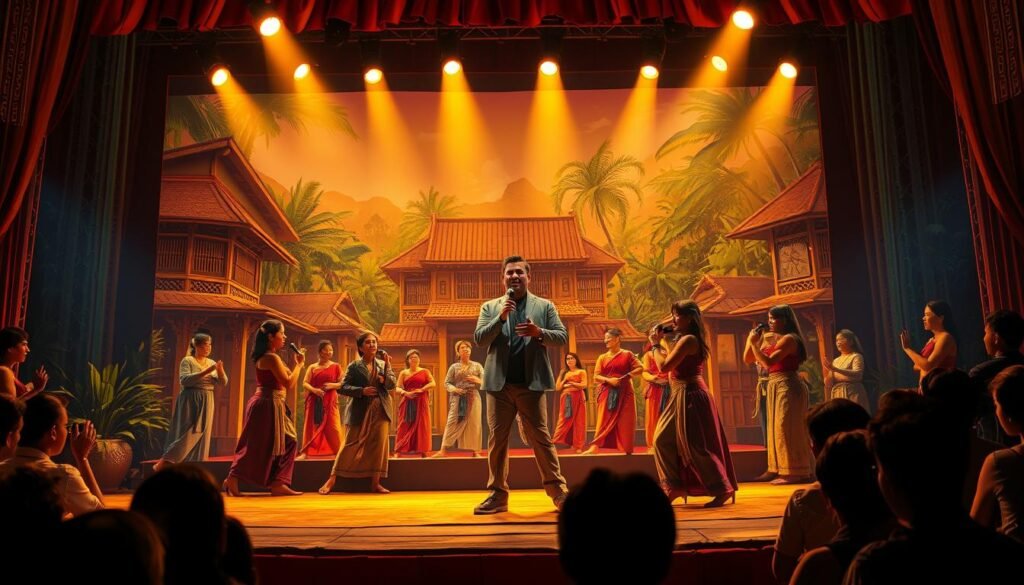
Iconic Productions and Their Impact
Iconic plays like “A Modern Filipina” and “Ang Huling El Bimbo” have left a lasting mark on Filipino society. These works not only entertained but also sparked conversations about social issues. The role of the director in these productions was crucial, as they guided the narrative to resonate with audiences.
Drawing inspiration from ancient Greek traditions, Filipino playwrights have used drama to address themes of justice, identity, and resilience. This blend of old and new has created a unique form of storytelling that continues to inspire.
Playwriting as a Reflection of Society
Playwriting in the Philippines has always been more than just art; it’s a commentary on society. Writers like Wilfrido Ma. Guerrero used their craft to highlight the concerns of the educated middle class. Their works often explored the tension between tradition and modernity, a recurring theme in Filipino drama.
Every element of a play—dialogue, setting, and character development—works together to capture the essence of the Filipino experience. This holistic approach ensures that the stories remain relevant and impactful.
“Filipino drama is not just entertainment; it’s a reflection of our collective soul.”
From the community stages to international festivals, Filipino plays have become a platform for cultural exchange. They showcase the nation’s rich history while addressing contemporary issues. This duality makes them a powerful force in shaping national identity.
For a deeper understanding of how Filipino drama has evolved, explore this detailed analysis of its postcolonial influences.
Historical Figures and Institutions in Filipino Theater
The development of Filipino drama has been shaped by visionary leaders and institutions over the years. These individuals and organizations have left an indelible mark on the art form, blending tradition with innovation to create a vibrant cultural legacy.
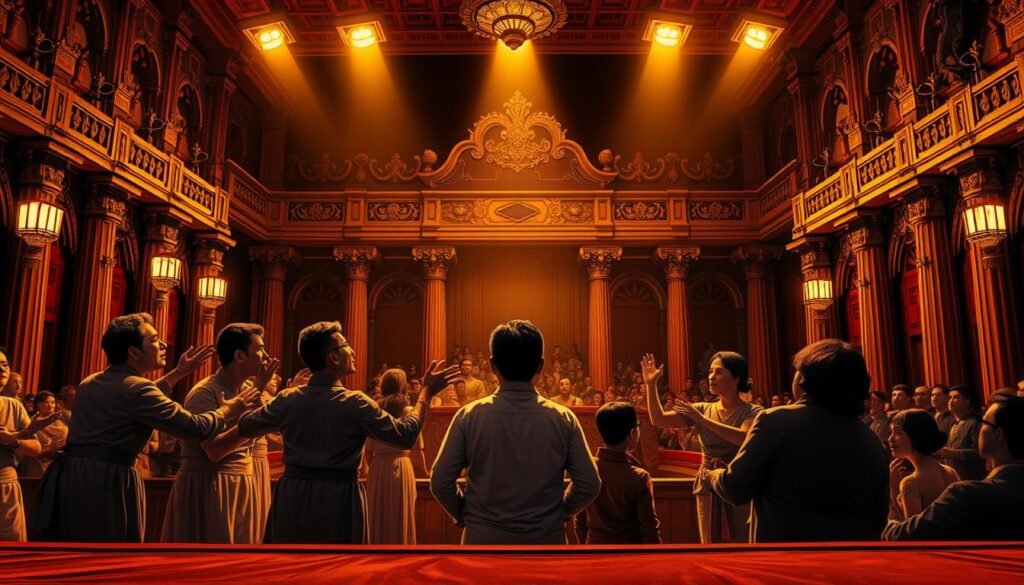
Influential Directors, Actors, and University Contributions
Directors like Wilfrido Ma. Guerrero and Tony Mabesa have played pivotal roles in shaping Filipino drama. Guerrero, known for his socially relevant plays, used his work to reflect the concerns of the educated middle class. Mabesa, on the other hand, focused on blending traditional and modern techniques, leaving a lasting influence on performance practices.
Actors such as Amelia Lapeña-Bonifacio have also made significant contributions. Her work in puppetry and children’s theater has introduced a unique way of storytelling, inspiring generations of artists. These figures have not only entertained but also educated, using drama as a tool for social commentary.
Universities have been instrumental in fostering the growth of Filipino drama. The University of the Philippines, for example, has been a hub for artistic innovation since its founding. Its theater programs have produced some of the country’s most renowned artists, ensuring the continuity of this rich tradition.
“The blend of heritage and innovation is what makes Filipino drama truly unique.”
Major Productions and Artistic Movements
Iconic productions like “A Modern Filipina” and “Ang Huling El Bimbo” have defined decades of Filipino drama. These works not only entertained but also sparked conversations about social issues, reflecting the influence of their creators.
The Cultural Center of the Philippines, inaugurated in 1969, has been a cornerstone of artistic expression. Its Main Theater, with a seating capacity of 1,853, has hosted countless performances, becoming a reference point for excellence in drama.
- 1966: Construction of the Cultural Center of the Philippines begins.
- 1969: Inauguration of the Cultural Center of the Philippines.
- 1988: Establishment of the CCP Museum, preserving the history of Filipino drama.
- 2022: Recognition of Amelia Lapeña-Bonifacio as a National Artist for Theater.
Institutions like the Philippine Educational Theater Association (PETA) have also played a crucial role. Founded in 1967, PETA has addressed social and political issues through drama, especially during the Martial Law era. Its contributions continue to shape the way Filipino drama evolves.
These figures and institutions have not only preserved traditional practices but also embraced modern trends. Their leadership and innovation have transformed performance practices, ensuring that Filipino drama remains a dynamic and evolving art form.
Comparative Analysis: Western vs. Filipino Theater
Western and Filipino performance traditions share a fascinating interplay of cultural exchange. While both have distinct roots, they also reveal surprising similarities in language, structure, and storytelling. This article explores the convergences and divergences between these two rich traditions, offering insights into their shared history and unique contributions to the world of performance art.
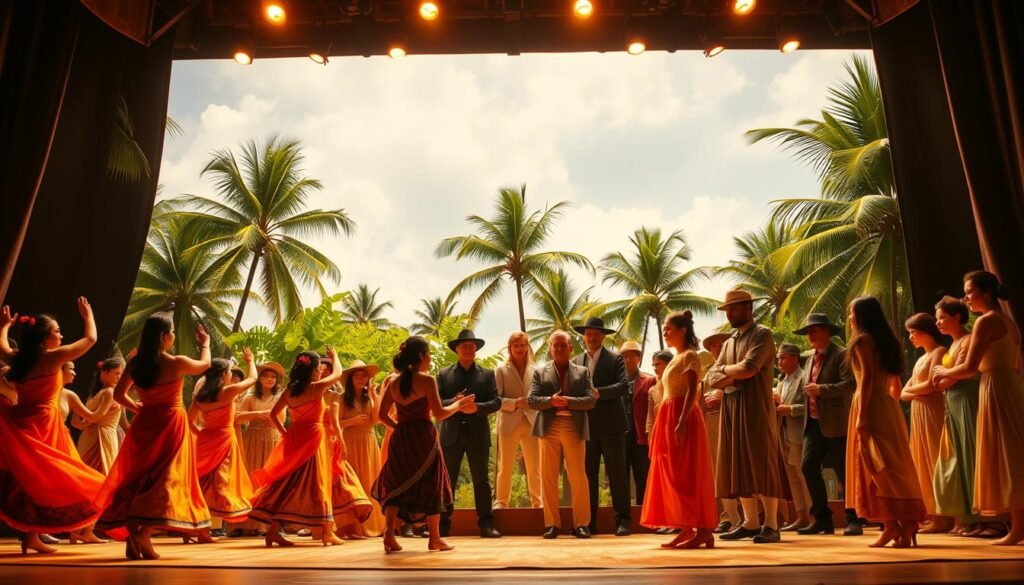
Similarities in Language and Performance Elements
One striking similarity lies in the use of language to convey emotion and narrative. Western opera, for example, relies heavily on musicality and vocal techniques to tell stories. Similarly, Filipino zarzuelas combine dialogue with music, creating a dynamic blend of spoken and sung performance. This shared emphasis on music as a storytelling tool highlights a universal fact about performance art: it transcends cultural boundaries.
Another parallel is the role of the city as a hub for artistic innovation. In both traditions, urban centers like New York and Manila have served as stages for groundbreaking productions. These cities have nurtured talent, fostered creativity, and provided audiences with access to diverse performances. This urban influence underscores the importance of location in shaping artistic expression.
Distinctive Cultural Narratives and Structures
Despite these similarities, Western and Filipino traditions diverge in their cultural narratives. Western opera often draws from classical mythology and historical events, while Filipino performances frequently explore themes of community, identity, and resilience. For instance, the komedya focuses on local legends and moral lessons, reflecting the values of Filipino society.
Stage architecture also differs significantly. Western stages often feature proscenium arches and elaborate sets, designed to create a sense of grandeur. In contrast, traditional Filipino performances were held in open spaces, emphasizing community participation. This difference in design reflects broader cultural priorities: spectacle versus inclusivity.
“The blend of Western and Filipino traditions has created a unique artistic dialogue, enriching both cultures.”
For a deeper understanding of these contrasts, explore this detailed analysis of Western and Filipino performance history.
| Aspect | Western Tradition | Filipino Tradition |
|---|---|---|
| Language | Opera, musical theater | Zarzuela, komedya |
| Narrative Themes | Mythology, history | Community, identity |
| Stage Design | Proscenium arches, elaborate sets | Open spaces, community participation |
| Urban Influence | New York, London | Manila, Cebu |
This comparative study reveals how Western and Filipino traditions have influenced each other while maintaining their unique identities. By examining these parallels and contrasts, we gain a deeper appreciation for the richness of global performance art. For further insights, refer to this comprehensive article on cultural exchange in performance traditions.
Theater: Influence on Filipino Community and Culture
Theater has always been more than just entertainment in the Philippines; it’s a reflection of community and culture. From traditional rituals to modern productions, live shows have played a pivotal role in shaping societal values and fostering unity. This section explores how theater has evolved into a powerful medium for cultural expression and social dialogue.
Evolution of Audience Engagement
Audience engagement in Filipino theater has transformed significantly over the years. Early performances, like the komedya, were community-driven events that brought people together. Today, modern productions incorporate film-inspired techniques, such as advanced lighting and sound design, to captivate audiences. This blend of tradition and innovation has deepened the meaning of live shows, making them more immersive and impactful.
For example, the Virgin Labfest’s transition to live streaming in 2020 demonstrated the adaptability of Filipino theater. Despite physical closures, the event maintained audience engagement through digital platforms. This shift highlights the resilience of the art form and its ability to evolve with changing times.
Cultural Impact and Community Dynamics
Theater has long been a mirror of Filipino society, reflecting its struggles, triumphs, and aspirations. Productions like Stageshow by Tanghalang Pilipino address social issues, sparking conversations within the community. These performances not only entertain but also educate, fostering a sense of shared identity and purpose.
Community involvement in theater has yielded meaningful results. Local productions often rely on volunteers, from actors to stagehands, creating a collaborative environment. This participation strengthens social bonds and ensures that theater remains a vital part of Filipino culture.
“Theater is not just a stage; it’s a platform for cultural dialogue and social change.”
From Passive Viewership to Active Participation
The relationship between audiences and theater has shifted from passive viewership to active cultural participation. Modern productions encourage audience interaction, blurring the lines between performers and spectators. This evolution has made theater more inclusive and engaging, ensuring its relevance in contemporary society.
For instance, the Philippine Educational Theater Association (PETA) has pioneered audience education programs. These initiatives empower communities to use theater as a tool for self-expression and advocacy. Such efforts underscore the transformative power of performance art.
| Aspect | Traditional Theater | Modern Theater |
|---|---|---|
| Audience Role | Passive viewers | Active participants |
| Production Techniques | Simple staging | Film-inspired effects |
| Cultural Impact | Community rituals | Social advocacy |
Theater continues to be a catalyst for social and cultural dialogue in the Philippines. Its ability to adapt and innovate ensures that it remains a vibrant and meaningful art form. For more insights into the diverse types of Filipino theater, explore this detailed guide.
Challenges and Future Directions in Filipino Theater
Filipino performance art stands at a crossroads, balancing tradition and modernity in a rapidly changing world. As the art form evolves, it faces significant challenges, from funding issues to shifting audience expectations. Yet, these obstacles also present opportunities for innovation and growth.
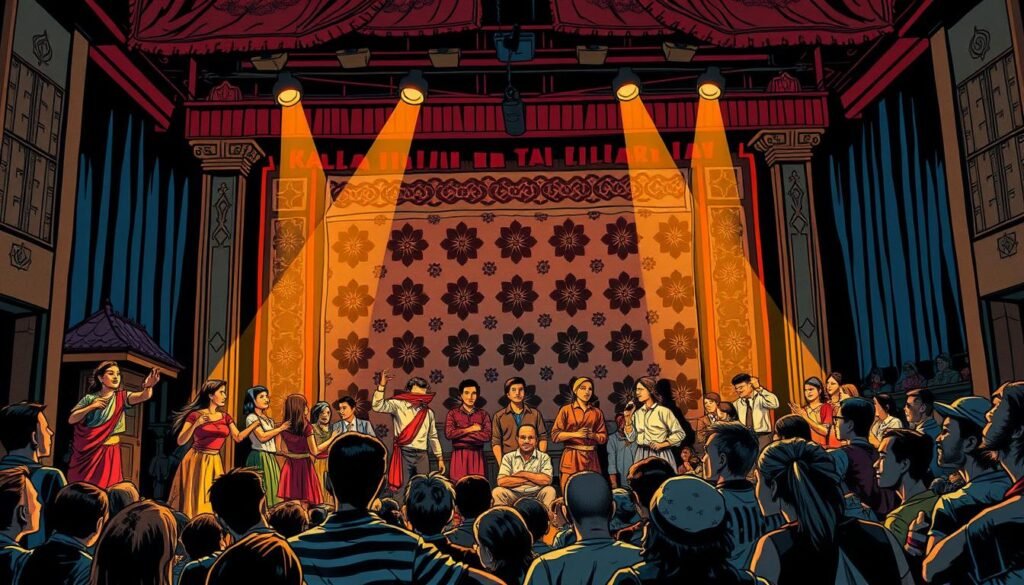
Preservation of Traditional Practices Amid Modern Trends
One of the most pressing challenges is preserving traditional practices while embracing modern trends. Many local productions struggle to maintain cultural authenticity in the face of western influences. For example, the rise of Broadway-style musicals has led to a decline in traditional forms like komedya and zarzuela.
Industry experts recommend a balanced approach. “We must honor our heritage while exploring new techniques,” says a veteran director. This course of action ensures that traditional expressions remain alive, even as the art form evolves.
Innovations Shaping the Future of Performance
Innovation is key to the future of Filipino performance art. Modern technology, such as digital projections and advanced sound systems, is transforming how stories are told. These tools allow artists to create immersive experiences that captivate audiences.
Collaborations with western theaters also offer fresh perspectives. For instance, the partnership between the Cultural Center of the Philippines and international theaters has led to groundbreaking productions. These initiatives demonstrate the potential for a side by side coexistence of heritage and innovation.
- Funding: Securing financial support remains a major hurdle for many productions.
- Cultural Preservation: Balancing tradition with modern trends is essential for maintaining cultural identity.
- Audience Engagement: Adapting to changing audience expectations is crucial for relevance.
“The future of Filipino theater lies in its ability to adapt while staying true to its roots.”
Looking ahead, the art form is poised for a dynamic evolution. By addressing these challenges head-on and embracing innovative strategies, Filipino theater can continue to thrive. For more insights into the development of community-driven initiatives, explore this detailed analysis.
Conclusion
Filipino performance art has evolved significantly, shaped by historical influences and modern innovations. From its roots in traditional storytelling to the integration of American techniques, the art form has continually adapted while preserving its cultural essence. This blend of old and new has created a dynamic platform for artistic expression.
Technical advancements and influential figures have played a crucial role in this evolution. Modern productions now incorporate advanced lighting and sound systems, enhancing audience engagement. These innovations ensure that every member of the community can connect with the stories being told.
The writing and staging of performances continue to reflect societal values and national identity. By combining tradition with innovation, Filipino artists ensure that their work remains relevant and impactful. This approach highlights the enduring use of performance art as a tool for cultural dialogue.
As we look to the future, it is essential for every member of the artistic community to build upon this rich heritage. By embracing both tradition and innovation, Filipino performance art can continue to thrive and inspire. For further insights into the evolution of performance art, explore this detailed analysis.
FAQ
How did American influence shape Filipino theater?
American influence introduced new performance styles, production techniques, and cultural exchanges, blending Western dramatic elements with traditional Filipino practices.
What are the historical roots of Filipino theater?
Filipino theater has deep roots in pre-colonial rituals, indigenous storytelling, and Spanish-influenced religious performances, forming a unique cultural foundation.
How did theater design evolve in the Philippines?
Filipino theater design drew inspiration from ancient Greek and Roman models, later incorporating modern stagecraft and technological advancements to create unique spatial transformations.
What role do plays play in shaping Filipino national identity?
Plays reflect societal issues, celebrate cultural heritage, and inspire national pride through iconic productions that resonate with audiences across generations.
Who are some key figures in Filipino theater history?
Influential directors, actors, and institutions like the University of the Philippines have significantly contributed to the growth and preservation of Filipino theater.
How does Filipino theater differ from Western theater?
While sharing similarities in language and performance elements, Filipino theater emphasizes distinctive cultural narratives and structures rooted in local traditions.
What challenges does Filipino theater face today?
Balancing the preservation of traditional practices with modern innovations remains a key challenge, alongside adapting to evolving audience expectations and technological trends.
How has audience engagement evolved in Filipino theater?
From community-centered rituals to modern productions, audience engagement has grown to include interactive performances and digital platforms, fostering deeper cultural connections.
What are some iconic Filipino theater productions?
Productions like “Noli Me Tangere” and “El Filibusterismo” adaptations have left a lasting impact, showcasing the power of theater in addressing social and historical themes.
How is Filipino theater adapting to modern trends?
By integrating Western techniques, embracing technological advancements, and exploring contemporary themes, Filipino theater continues to innovate while honoring its rich heritage.
Source Links
- The Evolution of Philippine Theatre
- History of Philippine Cinema – National Commission for Culture and the Arts
- Collected Essays 2: Philippine Theater Traditions, Relations, and Contestations
- A Simplified History of Traditional Theatres in the Philippines (Part 1)
- Filipino American theater
- In Focus: Philippine Theater in English – National Commission for Culture and the Arts
- Theatre – Evolution, Production, Design | Britannica
- Theatre design – Ancient, Renaissance, Modern | Britannica
- Fil-Am theater fest entry probes Filipino identity
- Endangered Theatre: A Philippine Notebook
- Glossary of theater terms
- Glossary of Technical Theatre Terms – Beginners – Theatrecrafts.com
- Glossary of stage and theater terms
- How Drama Can Cross Cultural Borders and Foster International Understanding
- Theatre Of Roots: Creating A National Identity By Promoting The Regional Elements
- Frontiers | Forming national identity with televised cultural rituals: a critical discourse analysis of China’s Ancient Rhyme and New Voice—Qingming program
- Tanghalang Pambansa
- National Artists of the Philippines – University of the Philippines Diliman
- Philippines – Culture, Diversity, Traditions | Britannica
- Situating Philippine Theatricality in Asia: A Critique on the Asian-ness / Philippine-ness of Philippine Theatre(s)
- THE MEDIATIZATION OF FILIPINO YOUTH CULTURE A Review of Literature
- THEATER; Filipino Life, Seen Through a Pop Culture Prism (Published 2001)
- Southeast Asian arts – Philippine Music, Dance, Crafts | Britannica
- The best Filipino theater of 2023
- Revitalizing Philippine Theater: A Framework for Theater as Creative Entrepreneurship – R Discovery
- Theater review: ‘Musikal!’ spotlights brio of original Filipino musical theater despite problems
- Conclusions
- Conclusion: Virus in the Theater
- Conclusion – Twentieth-Century British Theatre

